by Eron Iler | Sep 21, 2021 | Uncategorized
Getting a Sherp ATV stuck is no easy feat. This is the first time in over 3 years I have been involved in getting a Sherp stuck. Getting stuck in a Florida swamp was never really a consideration after going through so many nasty areas. In this situation the mud was very thin which provided little resistance to push against. The center of the rut was deep enough that the bottom rested on the mud and possibly a tree. The thin mud meant the Sherp had nothing to push off of to climb out or over the rut. Even changing the angle side to side did not allow the Sherp Pro XT from Argo to get traction and climb out.
The only other time a Sherp gets consistently stuck is in clay. Even the giant lugs on the Sherp ATV tires cannot eject all the mud so it builds up and prevents the Sherp from getting traction. With clay, the wetter the clay the better because it sticks less. When clay has just the right moisture it is sticky and slick.
We have all stepped in clay before and seen it stick to our boots as we slide around.
Getting unstuck is relatively easy in most instances. The best thing is to not assume the Sherp cannot get stuck or is indestructible. The Sherp can go many places other Argo vehicles cannot but it can still get stuck.
One method a customer pointed out is to get a few people to pull on a rope. This often provides enough pressure to enable the lugs on the tires to get traction. The Sherp Pro XT is considerably heavier than the older Pro so this is more difficult on the new Sherp.
Winching is familiar to anyone even considering the Sherp Pro XT. Carrying the needed straps axle and other supplies is just being smart. Think about what is needed to get a Sherp unstuck but more importantly how can you help others get unstuck. There are entire groups on social media dedicated to getting each other unstuck. I our area it is called Stuck in Florida.
I our area it is called Stuck in Florida.
What happens when you need to winch and there is not a tree or rock around to connect to? A great tip came from a customer who works in the waters of the Everglades. They carry a boat anchor and winch against it. Brilliant! They toss the anchor out get enough resistance to for the Sherp to get traction and get unstuck. The size of the anchor should match the terrain you are likely to encounter.
When winching a Sherp or any vehicle 99% of the time people attach the anchor point at waist level or below. I know I used to do it until an experienced equipment operator told me to winch up. By winching up you are lift the vehicle over the wall of mud, sand or debris that is blocking you. Why would you try to pull through it, instead of lifting over it? By lifting you are also breaking the suction below the vehicle make the entire recovery more efficient.
Don’t Go Off-Road Without
PubSafe
If you are like most off-road enthusiasts, bigger is better. It is possible to go to big and run into issues. The Sherp Pro XT weighs in at 5,180lbs so a winch rated at 8,000 to 10,000 lbs is about right. If you go bigger you run into a few possible issues.
It is possible to go to big and run into issues. The Sherp Pro XT weighs in at 5,180lbs so a winch rated at 8,000 to 10,000 lbs is about right. If you go bigger you run into a few possible issues.
The best way to get a pre-owned Sherp ATV is to jump on it as soon as it comes available. To get alerted of a Sherp going on the market like our Facebook page and watch for announcements. Sherps require a cash purchase so have the money ready. Sorry, but financing is not available.
Sorry, but financing is not available.
Fleetistics offers solar satellite trackers that work in the most remote area. Fleetistics also track trucks, trailers, boats, tanks.
I’m Interested!
Price Reduced
 Payment is due prior to pickup or shipping
Payment is due prior to pickup or shippingI’m Interested!
I’m Interested!
Used Sherp ATV Sales
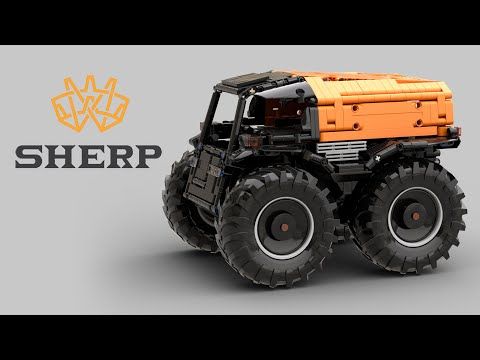 Save $30,000 to $40,000 off a new unit
Save $30,000 to $40,000 off a new unitUsed Sherp ATV Sales
Make a backup offer.
Used Sherp ATV Sales
 Due on order.
Due on order.  Due in full on order
Due in full on orderUsed Sherp ATV Sales – Canada
The Sherp ATV has many unique features that make it a highly versatile platform.
The Sherp ATV Pro comes standard with a ROPS. Other accessories shown are optional.
Other accessories shown are optional.
Inflate and deflate the tires without stopping. All tires are connected by a central tubing system that uses engine exhaust to inflate the tires. If you get a puncture, the positive pressure may enable you to keep traveling.
With a low center of gravity, the Sherp ATV can go places other off-road vehicles cannot and do it more safely.
The Sherp ATV is just at home in the water as on land. What makes it unique is the ability to operate on ice. The high buoyancy of the tires means breaking through the ice is not a death sentence. Rescuers can limit the risk of walking on the ice and simply drive to the victim.
Sherp, Sherp PRO and MAX floating snow and swamp vehicles have no analogues in the world all-terrain vehicle construction in terms of their characteristics and capabilities. This ultra-reliable technique is indispensable in rugged terrain with landscapes of varying complexity, and for those whose professional activities involve regular or systematic overcoming of various obstacles, it is categorically indispensable. A trouble-free car in any weather is guaranteed to pass where no human has ever set foot.
A trouble-free car in any weather is guaranteed to pass where no human has ever set foot.
Sherp is not just a good modern all-terrain vehicle - it is a "lifesaver" for hunters, rescuers, oilmen, gas workers, geologists and other specialists who trade, work or conduct research activities in absolute off-road conditions. The creation of the Sherp super passable amphibious snow and swamp vehicle is based on the advanced developments of domestic designers, which made it possible to set qualitatively new and the highest possible standards in the production of all-terrain vehicles.
The swamp walker on unique ultra-low pressure tires easily moves over stone boulders, easily overcomes fallen trees, as well as any other obstacles and barriers up to 100 cm high. special difficulties moves in deep snow and passes marshy swamps. But most importantly, the all-terrain vehicle gets out of the water onto the ice with incredible ease. Sherpa in any situation gives confidence and calmness!
Simple but reliable design based on a power frame, pneumocirculation suspension, smooth bottom, excellent ergonomics and controllability, compact overall dimensions and a rear-view camera with a monitor installed to increase traffic safety, allow not only comfortable movement on a swamp vehicle in confined spaces, but also transport it without any problems by towing it on a trailer using a passenger car.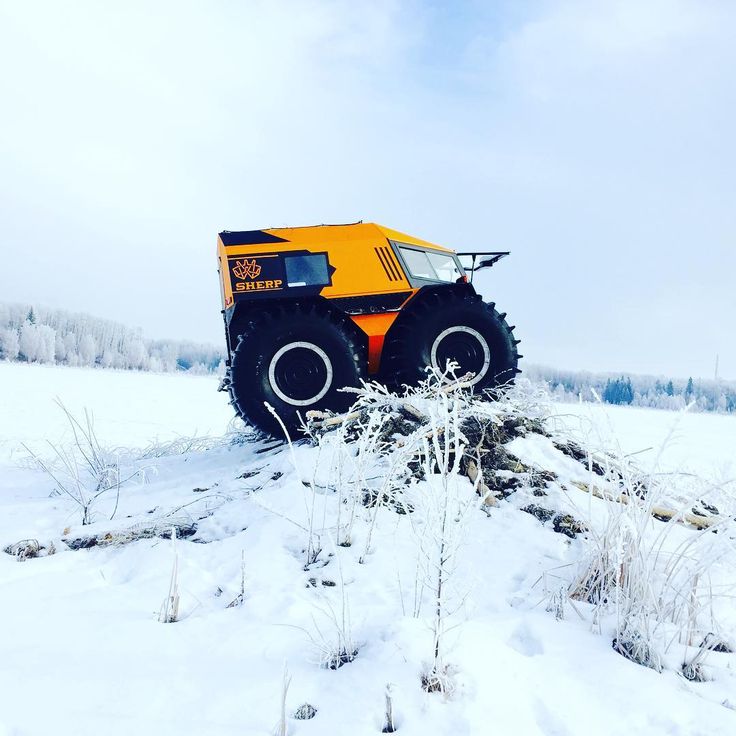 Sherp is easy to maintain and repair.
Sherp is easy to maintain and repair.
Japanese diesel engines Kubota, with a volume of four cylinders of 1500 cm³, when driving on any type of surface, have low fuel consumption for this class of equipment - only 2-3 l / h. Combined with a 56 L main fuel tank and four additional canisters built into the rims (58 L × 4), the vehicle has a high autonomy, and the vehicle's unsurpassed survivability is achieved due to the ability to continue moving when one or even two wheels are missing. .
The Sherp all-terrain vehicle is capable of "carrying" a payload of up to 1 ton. Two comfortable chairs with seat belts are installed in the covered cab. The interior of the cab and kung, where it is possible to accommodate four full-fledged beds, can be heated with warm air from the engine, a stove and / or an autonomous Webasto heater. In the hold, with a volume of 170 liters, available under the floorboards, it is possible to store things, tools, necessary equipment or use it to accommodate an additional fuel tank.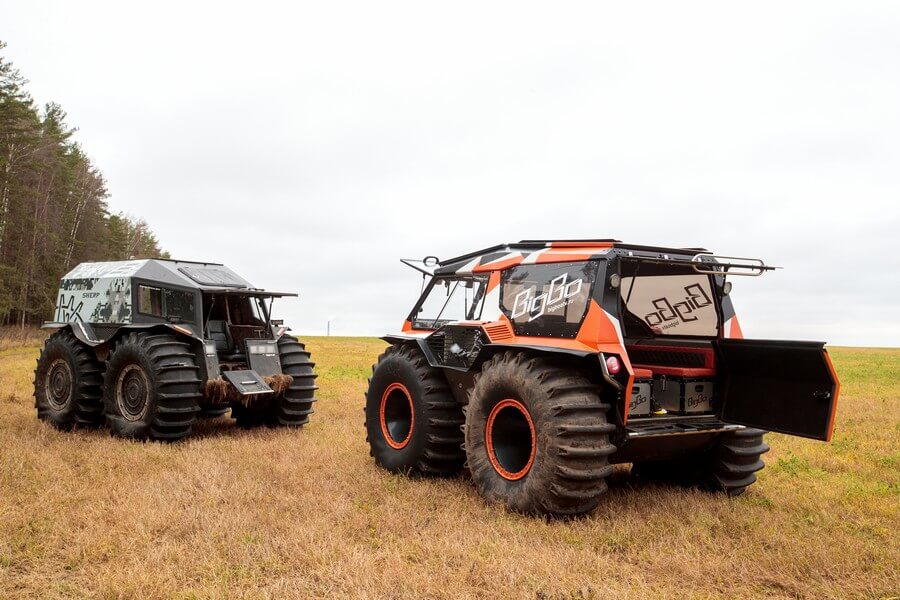
Sherp's tight turning radius makes it easy to maneuver through trees. The side turn allows the all-terrain vehicle to turn almost on the spot. Turns are carried out according to the principle of a caterpillar tank - only here not one of the tracks is blocked, but two wheels on the side of the car into which it is going to turn. The ability to overcome high obstacles, huge fallen trees and stone boulders, allows you to always get to the end point of the route.
Sherp all-terrain vehicle production, based and located in Russia, as well as unique Russian developments and innovative materials, make this special equipment unrivaled. The cost depends on the chosen model - Sherp with a metal body or Sherp PRO with an aluminum body. And in order to find out how much this or that option costs, ask the store staff for a price list of additional equipment in electronic form or call us at one of the contact phone numbers.
Additional options
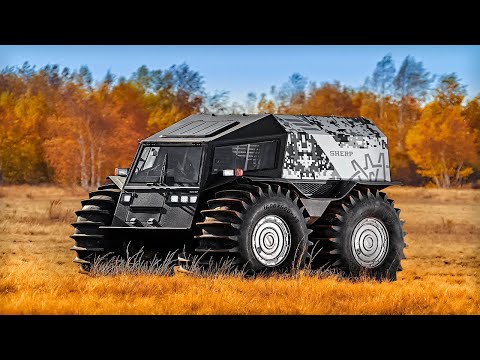
You can buy the Sherp all-terrain vehicle in the basic configuration, the price of which is indicated on the window, or in the individual. The manufacturer is attentive to each customer, therefore, if it is structurally possible, then it is quite possible to install non-standard equipment by agreement with the client. For example, Sherp has a specially designed navigation system. Also, you can buy a snow and swamp vehicle on lease or on credit. For any other additional information, please contact our staff.
Image copyright, Getty Images
In the morning he taught at school, and in the afternoon he went to the mountains to carry heavy bales weighing under 100 kg over rough terrain and rocky cliffs of the High Tatras. In the mountains, Peter Petras felt free from the restrictions and prohibitions of the communist regime.
In the mountains, Peter Petras felt free from the restrictions and prohibitions of the communist regime.
Now 75, he still works as a Sherpa porter several times a week. And he is not the oldest among the porters!
Slovak Sherpas, horský šerpa , have nothing to do with the Himalayan and Nepalese ethnic group. However, their occupation is the same - to carry a heavy load, necessary high in the mountains, in camp sites and alpine shelters (as they say in Slovakia, in huts).
Gorski Nosichi are unique in Europe - the services of Sherpas are nowhere else on the old continent. But in the High Tatras, these strong, hardy people still walk along steep mountain paths, loaded with huge bales of food and equipment, in spiked shoes, sometimes on skis, in any weather, in winter and summer.
How did it happen that the Slovak Sherpas were the only ones of their kind? Why are they still in service?
In the town of Stary Smokovec at the foot of the Slovak High Tatras in the wooden house of the Sherpa Museum, high, strong frames are leaning against the wall, to which local Sherpas attach the load and then put it on their backs like a huge backpack .
These frames resemble big sleds, toboggan, only with straps. Some are so tall they reach the ceiling. Some already have backpacks attached. With these frames behind them, the Sherpas carry 100 kg of cargo.
Skip the Podcast and continue reading.
Podcast
What was that?
We quickly, simply and clearly explain what happened, why it's important and what's next.
episodes
End of story Podcast
The High Tatras are the most popular tourist region in Slovakia with beautiful waterfalls, fabulous forests, lakes shining in the sun and picturesque valleys.
In the summer, millions of tourists come to the High Tatras and travel hundreds of kilometers along mountain routes, from one Alpine shelter to another. In winter, rocky ridges and mountain peaks, rising to 2500 m, are covered with snow and ice.
The last Sherpas of Europe follow the dangerous mountain paths from one shelter to another, using the entire set of climbing equipment and even carrying their heavy burden - sometimes along almost vertical slopes, at high altitude.
The frame alone to which the load is attached weighs up to 8 kg. And the entire load sometimes exceeds 100 kg - it consists of food, drinks, firewood and everything that is needed at camp sites - from gas cylinders to bed linen.
Sherpas work in any weather, at any time of the year - both in the heat of summer and in the icy cold of a mountain winter, when the temperature drops to minus 20, a piercing squally wind blows, and the mountain paths are covered with ice.
When I arrived here on a cold January day, the Swiss House, which houses the Sherpa Museum, was surrounded by snow. One of the oldest Sherpas, 75-year-old Peter Petras, was sitting in the Sherpa cafe next door and drinking tea.
He still - several times a week - carries heavy loads to mountain camp sites. But he is not the oldest of the local noses, whose age ranges from 17 to 79 years.
Image copyright, Štefan Bačkor
Image caption,Slovak Sherpas deliver goods where, due to strict environmental regulations, the things needed from above cannot be transported by cable car or helicopter
According to Petras, he works as a porter because he loves the mountains, not because of the money. "A porter is not a job, it's a way of life," he told me. "For a real mountain porter, money comes second. Being in the mountains comes first."
Each alpine shelter (you can call it a camp site) has its own caretaker, owner, and up to eight Sherpas who work in turns and live in the camp site.
Their duties include cleaning, cooking, snow removal and keeping the house warm. Sometimes porters help tourists make the right route.
Up to 60 Sherpas work in the mountains during the summer season. In winter - twice as much. For some of them, this is the main job, for others - an additional occupation. There are students among the porters.
Petras started dreaming about the mountains at the age of 10, when he saw how the work of the Sherpas was done by his elder brothers - Jojo and Ivan. Yojo was the strongest of the brothers: once he brought a slab weighing 137 kg to a height of 1960 m in the Big Studena Valley.
Peter Petras became a porter after graduating from school, but then went to serve in the army, and after the army he studied at the University of Bratislava, where he eventually received a Ph.D.
However, love for the Tatras did not let go, and in the mornings he taught, and in the afternoon he went to the mountains to work as a Sherpa. It was the perfect balance, he said.
It was the perfect balance, he said.
"When my school lessons ended, I could forget about teaching and be alone in nature, alone with myself. I had a psychological rest. And at school I had a physical rest," he says.
After Petras retired, he continued to work as a Sherpa: he renovated the oldest local alpine shelter, "Reiner's Hut" (built in 1863 as a shelter from bad weather), and now manages it.
Photo copyright, Getty Images
Image caption,Mountain camp sites and chalets provide shelter, food and warmth for tourists
Rainer's camp site is not suitable for housing, but tourists often stop at this small stone building to eat and see the collection of old Alpine equipment and skis collected by Petras.
In winter, he carves sculptures out of the snow. Peter is still able to carry a load of 60-70 kg to his "hut" (to a height of 1301 m), five to six times a week. On the way back, he picks up trash.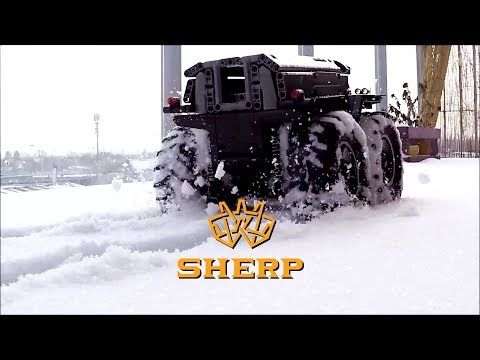
The hostel is only a 20-minute walk from the cable car station, so the journey is not long, but Petras used to work at the hostel, which took two hours to get to. “In winter, bad weather could take eight hours,” he recalls.
When tourism came to the Tatras in the mid-19th century, porters were paid to carry food and drink for groups of tourists. And when mountain routes were laid and alpine shelters were built where you could spend the night, the Sherpas carried building materials, and then food and fuel for these chalets.
This happened all over Europe, for example in the Alps. But when cable car routes were laid, when a highway was built in the mountains, porters were no longer needed. But not in Slovakia.
In the High Tatras, the "modernization" of the mountains has been reduced to a minimum, because this is a specially protected natural area and a biosphere reserve, so the Sherpas are still needed here, they cannot be dispensed with.
"The Sherpa knows that the chalet is expecting him and he must deliver the cargo anyway," says Petras.
"It's a very dangerous job," he adds. 20 years ago, a porter died in an avalanche. Another porter froze to death.
"It all looks romantic because we love what we do, but sometimes it's very dangerous. You have to experience loneliness, experience fear, experience cold. There are thunderstorms. Or you can just freeze."
Photo author, Štefan Bačkor
Photo caption,The load carried by a Sherpa can reach 100 kg
In his book, Petras lists the skills and psychological qualities necessary for a Sherpa: physical endurance, willpower, stamina, experience in the mountains, the ability to realistically assess their own strengths and abilities, dedication, humility and faith.
Shtevo "Pishta" Bachkor, who opened the Sherpa cafe and founded the museum with his wife Martina, worked as a professional Sherpa for more than 20 years, and even now keeps in shape several times a month so as not to lose touch with the mountain porters community.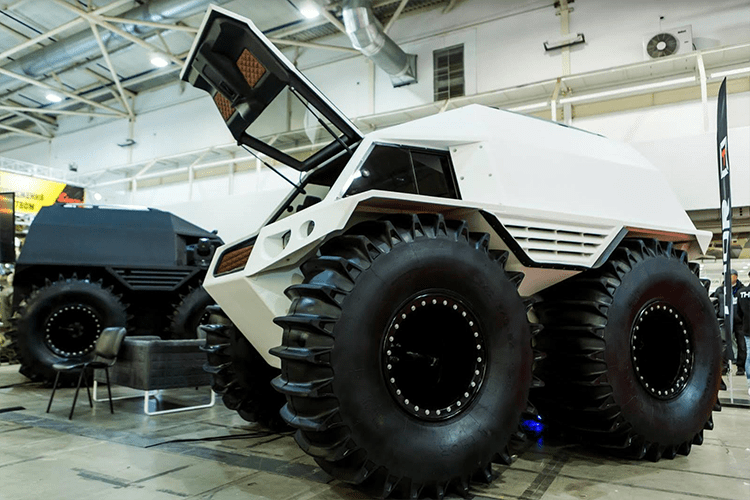
"I miss this job," he told me. "Almost everything in my life is connected with this community, with camp sites in the mountains." Bachkor also met Martina in the mountains, when she worked at one of the camp sites.
According to Bachkor, each time he goes to the mountains he feels a sense of freedom. But emotions are not only positive.
"On the one hand, it gives you pleasure, but at the same time you are a little worried about the weather. You can set off when the sun is shining, but in an hour you will be covered by a storm with wind speeds up to 150 km per hour and strong snowfall."
But if the tourists return in bad weather, the Sherpas keep going. Petras recalls one winter, when he first got wet to the skin in the mountains, and then it began to snow. When Petras reached the camp site, he literally iced over.
"It's not even about the temperature, it's more about the rapid weather changes," he says.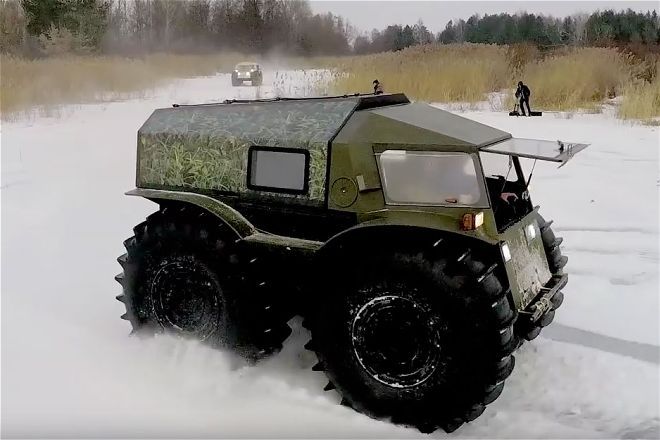 When he got to the chalet, he immediately ran to the kitchen and poured hot water from the kettle on his head and on his hands to melt the ice.
When he got to the chalet, he immediately ran to the kitchen and poured hot water from the kettle on his head and on his hands to melt the ice.
"There are things you just can't describe," he says.
Image copyright, Getty Images
Image caption,In the High Tatras in northern Slovakia, there are many hiking trails
According to Petras, the strongest Sherpa currently working - 69
The oldest, 79-year-old Laszlo Hudik, still works a couple of times a week - not for money but just for fun, says Bachkor. "He can't stop, real car."
Bachkor knows of only one Sherpa woman: she died in 2017 at the age of 92.
Many porters say that the most important thing for them is the feeling of freedom, and this was especially true during the years when Slovakia (then part of Czechoslovakia) was ruled by the communists.
"Every mountain hut is like an island of freedom," says Bachkor. "Under the communist system, working as a sherpa meant living free. After spending Saturdays and Sundays in the mountains, everyone went back to the offices and factories and dreamed about the upcoming weekend for a week in the mountains - about the days of freedom".
Petras also likes the Tatras because they are not too crowded. It's a UNESCO National Park and Biosphere Reserve, so no snowmobiles or ATVs - they're off limits to anyone except lifeguards.
The reserve is home to a wide variety of animals - brown bears, lynxes, wolves, foxes, marmots, snow voles and endangered chamois. Petras would like the Sherpas' profession to be protected in the same way - as a dying one.
According to him, this way of life helps him stay healthy and cheerful: "When people ask me how your health is, I answer: I don't know, I haven't been to a doctor for 20 years!"
Petras often goes high into the mountains to be alone and relax.